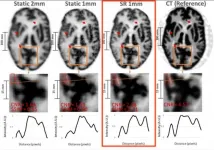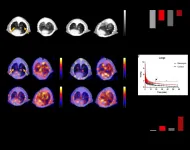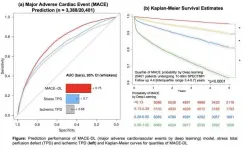INFORMATION:
IF REPORTING THIS STORY, PLEASE MENTION DEVELOPMENT AS THE SOURCE AND, IF REPORTING ONLINE, PLEASE CARRY A LINK TO:
https://journals.biologists.com/dev/article-lookup/doi/10.1242/dev.199216
REFERENCE: Fang, X., Gamallat, Y., Chen, Z., Mai, H., Zhou, P., Sun, C., Li, X., Li, H., Zheng, S., Liao, C., Yang, M., Li, Y., Yang, Z., Ma, C., Han, D., Zuo, L., Xu, W., Hu, H., Sun, L., Li, N. (2021) Hypomorphic and hypermorphic mouse models of Fsip2 indicate its dosage-dependent roles in sperm tail and acrosome formation. Development, 148, dev199216. doi:10.1242/dev.199216
doi:10.1242/dev.199216
This article is posted on this site to give advance access to other authorised media who may wish to report on this story. Full attribution is required, and if reporting online a link to journals.biologists.com/dev is also required. The story posted here is COPYRIGHTED. Therefore advance permission is required before any and every reproduction of each article in full. PLEASE CONTACT permissions@biologists.com
Hope for infertile men; mice could hold the secret
2021-06-14
(Press-News.org) Male infertility affects more than 20 million men globally and is a contributing cause to around 50% of infertility in couples. Frequently, male infertility is the result of defects in the sperm tail, the flagellum, which allows the sperm to swim toward an egg. Males with severe infertility can experience multiple sperm malformations, including flagella that are shortened, irregular, coiled or even absent, preventing them from swimming.
In humans, several genetic mutations lead to malformed sperm, including those affecting the sheath that covers the sperm; the mitochondria, which power sperm as they swim; and a tiny sac, the acromosal vesicle, which releases the enzymes that allow one successful sperm to break down the exterior lining of the egg cell to fertilize it.
To understand more about the causes of male infertility, Drs Na Li and Ling Sun, research group leaders at Guangzhou Women and Children's Medical Center, collected sperm samples from infertile men and identified one individual with multiple defects affecting his sperm flagella. Through genetic analysis, they found a mutation in a largely unknown sperm protein, FSIP2 (Fibrous Sheath-Interacting Protein 2), a component of the fibrous sheath. "The fibrous sheath covers the tails of sperm found in humans, mice and other species in which fertilisation occurs within the animal's body", explains Li. "It offers the sperm tails flexibility and strength, which is necessary for sperm to swim in the dense and sticky medium of the human body before they meet the egg. Interestingly, animals whose sperm swim through water because fertilization occurs outside of the body, such as fish, either do not have the FSIP2 protein or, at most, a defective version."
To study the function of FSIP2, Li, Sun and their team of researchers generated two sets of mice: one in which they recreated the FSIP2 mutation of the human patient and another in which the animals overproduce the FSIP2 protein. They found that mice with the FSIP2 mutation become infertile; their semen contained fewer live sperm and over 50% could not swim forward, even though some of them could still beat their flagella. In contrast, the mice that overproduced the FSIP2 protein remained fertile and, compared to normal mice, had over 7 times more super-long sperm, which could swim faster and be more capable of fertilizing an egg.
To understand the reasons for these changes in the sperm flagella, the researchers looked at the composition of the sperm. They found that the sperm of mice with the FSIP2 mutation had lower amounts of the proteins that make up the sheath surrounding the sperm, the mitochondrial power generators and the acrosomal vesicle. In contrast, the sperm of the mice that were overproducing FSIP2 made more sperm tail proteins, particularly in the fibrous sheath, which could allow sperm to swim more easily through the body. They published this discovery in Development at http://journals.biologists.com/dev.
The findings of Li, Sun and their team offer hope that scientists can begin to develop treatments for infertility, either by finding drugs that restore sperm movement or even by finding ways to correct the debilitating mutation that causes the problems in the first place. Ultimately, such treatments could give men suffering from infertility the chance of becoming fathers.
ELSE PRESS RELEASES FROM THIS DATE:
Study effects paradigm shift in the understanding of how red rot attacks sugarcane
2021-06-14
The fungus Fusarium verticillioides is one of the causes of red rot, the most serious sugarcane disease. Losses average around USD 1 billion per harvest in Brazil alone.
The traditional approach to the etiology of this disease is that it is triggered by Diatraea saccharalis, a moth usually referred to as the sugarcane borer. In the caterpillar stage, this insect bores into the stem of the plant, which is later infected opportunistically by the fungus.
However, a study conducted in Brazil by the University of São Paulo's Luiz de Queiroz College of Agriculture (ESALQ-USP) has turned this model upside down, showing that the trigger is not the insect but the fungus. "It's the first scientifically demonstrated case of a pathogenic ...
Young adults who lost and then restored heart health had lower risk of heart attack, stroke
2021-06-14
DALLAS, June 14, 2021 -- Preserving good cardiovascular health during young adulthood is one of the best ways to reduce risks of premature heart attack or stroke, according to new research published today in the American Heart Association's flagship journal Circulation.
The number of premature deaths from cardiovascular disease is increasing in many countries including the U.S. While there is a wealth of information available on maintaining good heart health during and after midlife to reduce the risks of heart attack and stroke, data about cardiovascular health during young adulthood is scarce.
"Most ...
Ibuprofen and other NSAIDs superior to codeine for managing outpatient postoperative pain
2021-06-14
Nonsteroidal anti-inflammatory drugs (NSAIDs) such as ibuprofen provide better pain control and have fewer adverse effects than codeine, a commonly prescribed opioid, when prescribed after outpatient surgery, according to new research published in CMAJ (Canadian Medical Association Journal) https://www.cmaj.ca/lookup/doi/10.1503/cmaj.201915.
"In all surgery types, subgroups and outcome time points, NSAIDs were equal or superior to codeine for postoperative pain," writes Dr. Matthew Choi, Associate Professor of Surgery, McMaster University, with coauthors.
The researchers conducted a systematic review and meta-analysis of 40 high-quality randomized controlled trials (RCTs) involving more than 5100 adults to compare pain levels and safety of medications containing codeine, such as Tylenol ...
Barks in the night lead to the discovery of new species
2021-06-14
The raucous calls of tree hyraxes -- small, herbivorous mammals -- reverberate through the night in the forests of West and Central Africa, but their sound differs depending on the location.
Tree hyraxes living between the Volta and Niger rivers make a barking call that is distinct from the shrieking vocalizations of hyraxes inhabiting other regions of the African forest zone.
A new study in the Zoological Journal of the Linnean Society co-authored by Yale anthropologist Eric Sargis finds that the barking hyraxes are a separate species from their shrieking neighbors. The newly described species, Dendrohyrax interfluvialis, ...
New super-resolution technique allows for more detailed brain imaging
2021-06-14
Reston, VA (Embargoed until 5:00 p.m. EDT, Sunday, June 13, 2021) - A new imaging technique has the potential to detect neurological disorders--such as Alzheimer's disease--at their earliest stages, enabling physicians to diagnose and treat patients more quickly. Termed super-resolution, the imaging methodology combines position emission tomography (PET) with an external motion tracking device to create highly detailed images of the brain. This research was presented at the Society of Nuclear Medicine and Molecular Imaging's 2021 Virtual Annual Meeting.
In brain PET imaging, the quality of the images ...
Radiotracer effective for detection and assessment of lung fibrosis
2021-06-12
Reston, VA (Embargoed until 4:30 p.m. EDT, Saturday, June 12, 2021)--Positron emission tomography (PET) using a 68Ga-labeled fibroblast activation protein inhibitor (FAPI) can noninvasively identify and monitor pulmonary fibrosis, according to research presented at the Society of Nuclear Medicine and Molecular Imaging 2021 Annual Meeting. By binding to activated fibroblasts present in affected lungs, FAPI-PET allows for direct imaging of the disease process.
Idiopathic pulmonary fibrosis (IPF) causes substantial scarring to the lungs, making it difficult for ...
Deep learning with SPECT accurately predicts major adverse cardiac events
2021-06-12
Reston, VA (Embargoed until 6:15 p.m. EDT, Friday, June 11, 2021)--An advanced artificial intelligence technique known as deep learning can predict major adverse cardiac events more accurately than current standard imaging protocols, according to research presented at the Society of Nuclear Medicine and Molecular Imaging 2021 Annual Meeting. Utilizing data from a registry of more than 20,000 patients, researchers developed a novel deep learning network that has the potential to provide patients with an individualized prediction of their annualized risk for adverse events such as heart attack or death.
Deep learning is a subset of artificial intelligence that mimics the workings of the human brain to process ...
Pine Island Glacier's ice shelf is ripping apart, speeding up key Antarctic glacier
2021-06-11
For decades, the ice shelf helping to hold back one of the fastest-moving glaciers in Antarctica has gradually thinned. Analysis of satellite images reveals a more dramatic process in recent years: From 2017 to 2020, large icebergs at the ice shelf's edge broke off, and the glacier sped up.
Since floating ice shelves help to hold back the larger grounded mass of the glacier, the recent speedup due to the weakening edge could shorten the timeline for Pine Island Glacier's eventual collapse into the sea. The study from researchers at the University of Washington and British Antarctic Survey was published June 11 in the open-access journal Science Advances.
"We may not have the luxury of waiting for slow changes on Pine Island; things could actually go much quicker than expected," ...
New discovery shows human cells can write RNA sequences into DNA
2021-06-11
PHILADELPHIA - Cells contain machinery that duplicates DNA into a new set that goes into a newly formed cell. That same class of machines, called polymerases, also build RNA messages, which are like notes copied from the central DNA repository of recipes, so they can be read more efficiently into proteins. But polymerases were thought to only work in one direction DNA into DNA or RNA. This prevents RNA messages from being rewritten back into the master recipe book of genomic DNA. Now, Thomas Jefferson University researchers provide the first evidence that RNA segments can be written back into DNA, which potentially challenges the central dogma in biology and could have wide implications ...
Vitamin D deficiency may increase risk for addiction to opioids and ultraviolet rays
2021-06-11
BOSTON - Vitamin D deficiency strongly exaggerates the craving for and effects of opioids, potentially increasing the risk for dependence and addiction, according to a new study led by researchers at Massachusetts General Hospital (MGH). These findings, published in Science Advances, suggest that addressing the common problem of vitamin D deficiency with inexpensive supplements could play a part in combating the ongoing scourge of opioid addiction.
Earlier work by David E. Fisher, MD, PhD, director of the Mass General Cancer Center's Melanoma Program and director of MGH's Cutaneous Biology Research Center (CBRC), laid the foundation for the current study. In 2007, Fisher and his team found something unexpected: Exposure to ultraviolet (UV) rays ...



